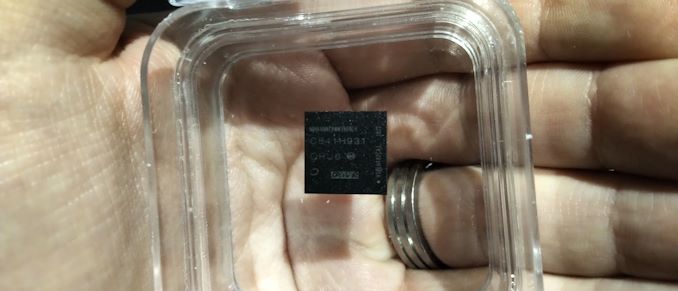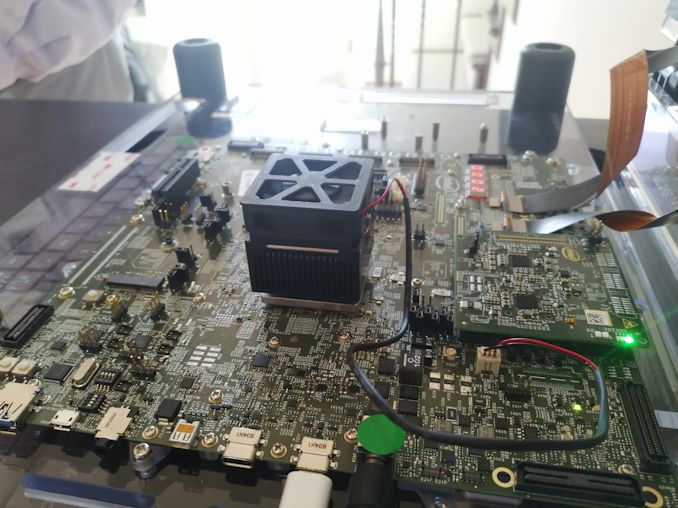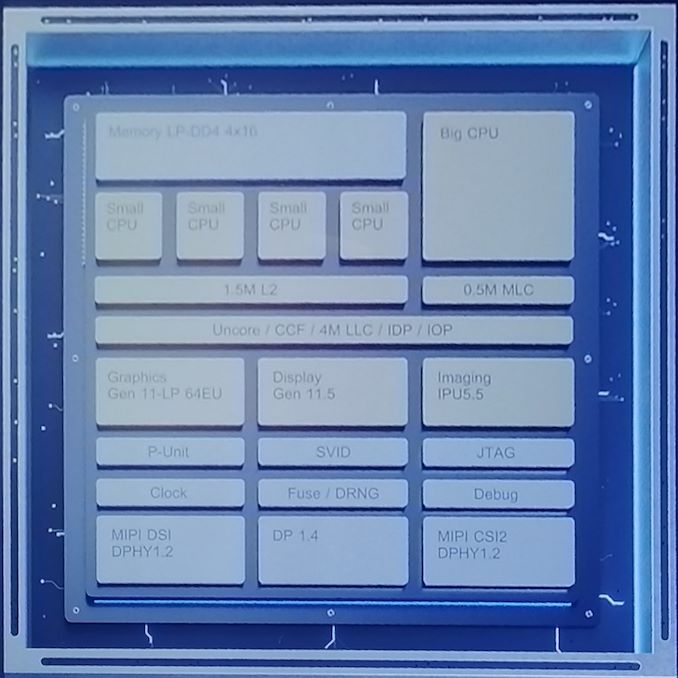CES 2019 Quick Bytes: Intel’s 10nm Hybrid x86 Foveros Chip is Called Lakefield
by Ian Cutress on January 7, 2019 7:50 PM EST- Posted in
- CPUs
- Intel
- Trade Shows
- 10nm
- Tremont
- FOVEROS
- CES 2019
- Lakefield
- Sunny Cove

At Intel’s Architecture Day, the company showed off a new stacking technology called ‘Foveros’, which is designed to allows the company to make smaller chips. The idea behind Foveros is to have a base ‘interposer’ that also integrates common I/O functionality, while using connections through the chip to another piece of silicon on top that has the CPU cores and the graphics subsystem. We saw chips that were working and processing data, and it all looked really cool.
The reason this chip exists is because one of Intel’s customers requested a processor with integrated graphics that can idle at 2 milliwatts. After a few years of engineering, Intel is finally there. There’s also another trick at play here.
The chip uses a combination of Intel’s high power and low power cores. Inside the new chip, which Intel announced at CES is called Lakefield, is one of its high-powered Core architecture Sunny Cove cores, and four low-powered Tremont Atom cores. This is the first Intel chip, or consumer chip at least, to use both core designs at once. This is fairly common for Arm chips in smartphones, but we have not seen it yet in the PC space. We have a block diagram showing cache layouts and things, and at the first showing, Intel’s Jim Keller said that the company were having fun with the technology with designing things that could become future parts.
Today’s announcement is around the Lakefield family name for the processor. We’re expecting this to generate a family of *field parts in the future.
For bonus guesses, we think that this chip is likely to end up in something like Lenovo’s Yogabook, rather than anything from Apple. That’s our professional opinion. Or it could end up in a tablet, or something with a new use case or form factor.
Quick Bytes are shortened news pieces about topics mentioned at large press events. Because sometimes smaller announcements get buried at a keynote presentation because a dozen key points are mentioned in one article, and our Quick Bytes series separates out a few topics for targeted discussion. You can read the full article here.












10 Comments
View All Comments
Alexvrb - Monday, January 7, 2019 - link
Do all the cores support all the same extended instructions?serendip - Monday, January 7, 2019 - link
Finally Intel has an answer to ARM's big.little or DynamIQ or whatever horrendous acronym they'll come up with next. This chip would be perfect for Windows tablets like the Surface Pros and Gos. Let the Atom cores do most of the usual work and let the Sunny Cove cores fire up for app loading and heavy crunching. Windows needs a new x86 scheduler to support this though.Jorgp2 - Monday, January 7, 2019 - link
With that big a GPU, that thing is defenitely built for a mobile console.darkswordsman17 - Monday, January 7, 2019 - link
I speculated that it was for HoloLens gen 2, but that doesn't seem to be the case. Would be a solid chip for standalone VR/AR headset.Jorgp2 - Monday, January 7, 2019 - link
I just thought it could be for an Xbox companion device.But they would probably go AMD for that.
bubblyboo - Monday, January 7, 2019 - link
That's the big CPU, but these likely aren't to scale. Intel has a long way to go before their iGPUs are even close to viable.Jorgp2 - Monday, January 7, 2019 - link
If you read the image you will see it has 64 EUs.Thats what Iris parts had.
GreenReaper - Tuesday, January 8, 2019 - link
They *also* had a shitload or two (technical term for 64MB) of eDRAM as cache:https://en.wikipedia.org/wiki/EDRAM
RarG123 - Monday, January 7, 2019 - link
Lakefield? We going back to Nehalem? :Pbeginner99 - Tuesday, January 8, 2019 - link
A chip like this makes sense in tablets or laptops. When your are at a conference (like CES) and mostly maybe do some typing and web browsing on your laptop that should be easily handled by atom cores and hence increase battery life. When gaming or something more demanding, the big cores will become useful.